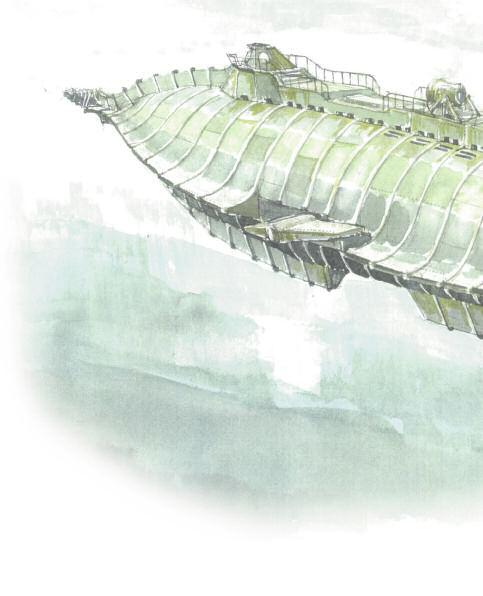
38 minute read
The Submarine Technology of Jules Verne
s an inspiration to the submarine pioneers of the A late 19th and early 20th centuries, no other literary figure loomed as large as Jules Verne, the “father of science-fiction” and the author in 1870 of Twenty Thousand Leagues Under the Sea. American submarine inventor Simon Lake, for example, credited his life-long interest in undersea exploration to having read Verne’s novel as a boy – and in 1898, he was thrilled to receive a telegram of congratulations from the author himself when his own Argonaut completed its first substantial ocean-going voyage. Educated as a lawyer, Verne lacked formal training in science and engineering, but nonetheless chose so shrewdly from the speculative technologies of his day in creating a futuristic submarine for his protagonist, Captain Nemo, that the essentials of his undersea vision – examined here – have nearly all been realized.
Born in the French port city of Nantes, Jules Verne (1828-1905) was educated for the law and worked as a stockbroker, but his literary and technical interests eventually brought him enormous success as the first real “science fiction” novelist. He wrote Twenty Thousand Leagues Under the Sea in 1870.
Advertisement
Paris, the Law, and Literature
Jules-Gabriel Verne was born in 1828 in the French seaport of Nantes, upriver from the Bay of Biscay. Although his younger brother Paul became a naval officer, and Jules attempted to run away to sea in his early teens, his lawyer father intended that he should enter the legal profession and sent him to Paris in 1847 to study law. There, provided an entrée by his uncle, he joined the literary circle of Alexander Dumas, pere et fils, and while continuing his legal studies, turned increasingly to writing plays, articles, and stories. In 1849, Verne passed his law degree, but his father grudgingly agreed to his remaining in Paris to pursue a literary career. Over the next several years, he published a series of short stories to no particular acclaim, served as secretary of the Théâtre Lyrique, and collaborated on an operetta libretto. Then, in 1857, having married a young widow from Amiens with two children, he accepted employment as a stockbroker, presumably because it promised a more reliable income.
Even so, Verne continued his literary work and simultaneously began indulging a latent interest in natural science and technology by reading assiduously on geology, engineering, and astronomy in the libraries of Paris. The first fruits of this dual avocation were his 1863 novel Five Weeks in a Balloon, which achieved immediate success in establishing the new genre of “science fiction.” This was followed, with growing acclaim, by Journey to the Center of the Earth in 1864, From the Earth to the Moon in 1865, and then by Twenty Thousand Leagues Under the Sea in 1870. 1 By then, Verne had given up his stockbroker practice and devoted himself entirely to writing.
Verne’s Tale of Undersea Adventure
Verne’s plot in Twenty Thousand Leagues is relatively simple and serves largely as a framework for describing both the wonders of the underwater world and the technologies needed to realize the author’s prophetic vision of undersea travel and exploration. The year is 1866, and the maritime community is shaken by sporadic sightings of what appears to be a gigantic sea creature unlike any seen before. When this “cetacean” collides with two merchant ships and nearly sinks them, the U.S. Navy sends the steam frigate Abraham Lincoln to hunt the creature down, augmenting her crew with a French naturalist, Professor Pierre Aronnax – who narrates the tale – his servant Conseil, and American master harpooner Ned Land. After fruitlessly searching down the eastern coast of South America and over much of the Pacific, Lincoln happens on the “monster” southeast of Japan and attempts to subdue it with both cannon-fire and harpoon. In response, the beast inundates the frigate with jets of water and carries away her rudder in a ramming attack that also throws Aronnax, Conseil, and Land into the sea.
Deserted by Lincoln, the three castaways soon find themselves marooned on the “back” of the creature, which is, in fact, an advanced submarine – the Nautilus – designed, built, and commanded by the mysterious Captain Nemo, who takes Aronnax,
Conseil, and Land onboard as his prisoners but gives them the run of the ship. There follows a long underwater adventure – 20,000 leagues under the sea 2 – in which the Nautilus explores virtually the entire world ocean and the sea floor beneath. Aronnax is fascinated by this extraordinary access to the undersea realm and the research opportunities it affords him in his specialty. From his long conversations with Nemo, we learn how Nautilus is designed and operated, of its total independence of support from land, and of the submarine’s “mission” to roam the globe supporting struggles against tyrannical oppression. Meanwhile, Ned Land is increasingly frustrated by his confinement and eventually convinces the professor and Conseil to join him in escaping from Nemo. Just as this attempt gets underway, the Nautilus is sucked into that legendary whirlpool, the Maelstrom, off the coast of Norway, and when the resulting violence subsides, presumably only Aronnax, Conseil, and Land have survived to be picked up by a passing ship and tell the story. 3
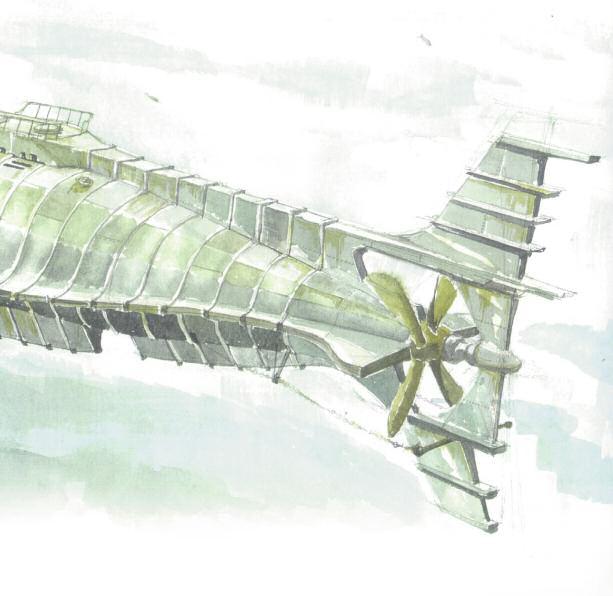
Nemo’s Submarine Precursors
Although very early submarine experimenters such as Cornelius van Drebbel in early 17th-century London and David Bushnell in the American Revolution had demonstrated occasional successes, it was only in the early and mid-19th century that the problems of underwater navigation were attacked in earnest. In France, for instance, the American Robert Fulton – later renowned as the “inventor” of the steamboat – attempted to win the support of the government of First Consul Napoleon Bonaparte for an undersea craft capable of breaking the British blockade. Awarded a contract for building a man-powered submersible of his own design, Fulton christened his boat Nautilus – the same name chosen by Jules Verne 70 years later –
Although the most familiar latter-day representation of Nautilus was created and for the 1954 Walt successDisney movie version fully demonstrated it on the Seine in 1800 and later of Twenty Thousand Leagues Under the Sea, there have been many others over the years. at Le Havre. Napoleon Here, for example, is an soon lost interest in imaginative and superbly Fulton’s initiative, but subsequently, he supported the evalurendered concept by English artist Dave Warren. ation of a less-expensive wooden submersible built at Le Havre by two brothers named Coessin. Their prototype achieved some limited success, but then nothing more was heard of it.
In the 1830s and 1840s, several other French inventors –DeMontgery, Petit, Villeroi, and Payerne – offered other submersible concepts, and some were actually built. But it was only when the French Navy became interested in a design by Captain Simon Bourgeois and naval constructor Charles Brun that significant progress was made. In 1863, Bourgeois and Brun launched Le Plongeur(“the Diver”) at Rochefort and experimented with the boat for three years. Powered by a reciprocating engine driven by stored compressed air, the 140-foot long Le Plongeur managed to average five knots submerged but suffered from inadequate longitudinal stability and was eventually abandoned. At the same time, other European countries were pursuing their own submarine programs, and on the far side of the Atlantic, the American Civil War had stimulated more immediate interest in submersible
(top) Reproduced from the original 1871 French edition published by J. Hetzel et Cie in Paris, this engraving shows Captain Nemo’s Nautilus underway as Verne himself must have envisioned it. In this view, the craft is moving from right to left, the course ahead illuminated by a powerful electric searchlight mounted abaft the pilothouse.
(bottom) In another first-edition engraving, Captain Nemo is portrayed at Nautilus’s wheel behind the “bi-convex” windows of the small pilothouse. Nemo’s cloudy origins are only fully revealed in Jules Verne’s 1875 novel, The Mysterious Island, where it emerges that he was born an Indian prince and educated in Europe, before his overthrow by the British led him to build Nautilus as a weapon against tyranny and oppression worldwide.
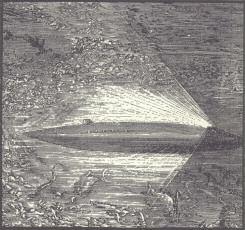
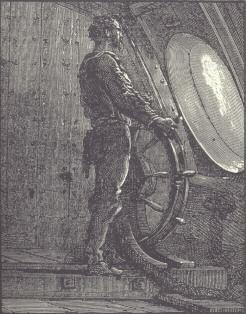
combatants, particularly in the Confederacy, where raising the Union economic blockade was a primary objective. There, the most spectacular success was achieved by the hand-cranked submersible CSS Hunley, which in February 1864 sank the USS Housatonic in Charleston Harbor – the first-ever sinking of a warship by a submarine. In light of his voracious reading and exhaustive reportage of the Civil War by the European press, Jules Verne would certainly have known of these events at the time he embarked on writing Twenty Thousand Leagues Under the Sea.
For the submarine community, Twenty Thousand Leagues Under the Sea raises fascinating questions: Just how prophetic was Verne in exploiting technologies nascent in 1870 to create Captain Nemo’s Nautilus? How accurately did he predict the actual evolution of the modern submarine? And how many of the undersea innovations he envisioned 130 years ago have actually been realized?
Designing and Building Nautilus
According to Verne’s tale, Captain Nemo and his men built Nautilus on a desert island in total secrecy by ordering components and materials from disparate sources and arranging their delivery to a variety of covert addresses. The design was entirely Nemo’s, based on the engineering knowledge he had gained from extensive study in London, Paris, and New York during an earlier part of his life. The steel double hull is spindle-shaped and 70 meters (230 feet) long, with a maximum diameter of 8 meters (just over 26 feet). As Captain Nemo describes it,
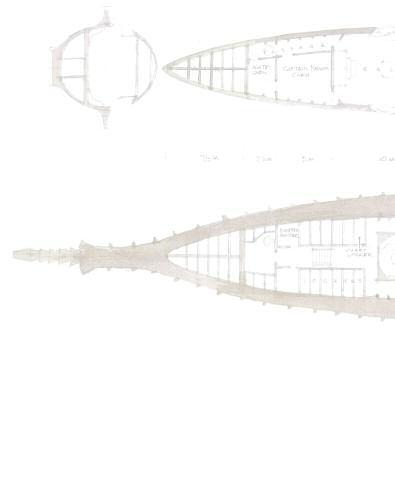
…Nautilus has two hulls, one interior, one exterior, and they are joined by iron T-bars, which gives the boat a terrific rigidity. Because of this cellular arrangement, it has the resistance of a solid block. The plating can’t yield; it’s self-adhering and not dependent on rivets; and the homogeneity of its construction, due to the perfect union of the materials involved, permits it to defy the most violent of seas. 4
Submerged, the submarine displaces 1,507 metric tons (roughly 1,670 short tons) and surfaced, with only one-tenth of the hull above the water, it displaces 1,356 metric tons (1,495 short tons) – Verne is quite precise about this. 5
Nautilus is controlled from a small, retractable pilothouse set into the top of the hull about a quarter of the way back from the bow. Several large bi-convex glass windows – 21 centimeters thick at the center – provide an all-around view, augmented by illumination from a separate electric searchlight mounted in an external pod abaft the pilothouse. There is no periscope – these would not come into general use for more than three decades. For use while surfaced, a small, flat deck fitted with removable manropes is apparently installed just behind the pilothouse, and this can be accessed by a hatch from below. Nemo and his first mate frequently use this platform for celestial navigation in conjunction with a pit log read out by electrical telemetry. The only other protuberance topside is a low “dry-deck shelter” faired into the hull for housing a metal dinghy that can be entered and launched from within, even while underwater.
Electricity – A “Powerful Agent”
With its imaginative technology, Nemo’s engineering plant for Nautilus is certainly the most extraordinary aspect of his design. On behalf of his nautical protagonist, Verne conceived what was essentially an “all-electric” ship at a time when the first practical
applications of electricity were only a few decades old and a century before building any such ships became feasible. In Captain Nemo’s oft-quoted words,
There is a powerful agent, obedient, rapid, facile, which can be put to any use and reigns supreme on board my ship. It does everything. It illuminates our ship, it warms us, it is the soul of our mechanical apparatus. This agent is – electricity.
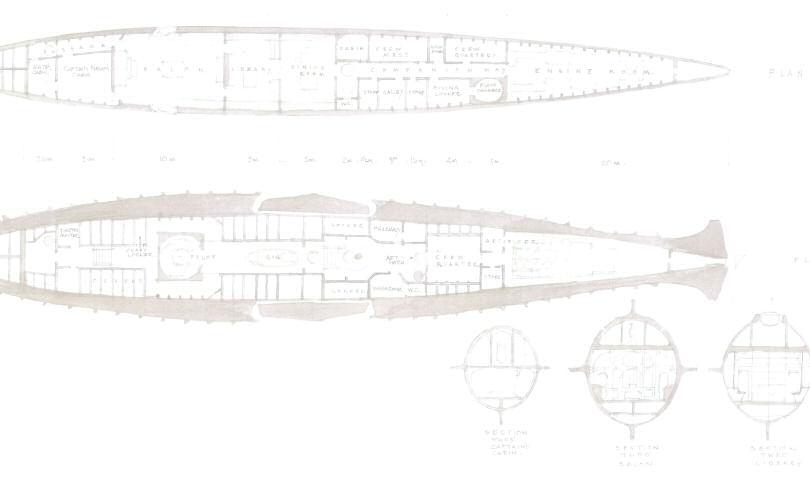
And indeed, Nautilus uses electricity for cooking, lighting, distilling fresh water, running pumps and other auxiliaries, instrumentation, and, of course, main propulsion. The ship is fitted with a conventional four-bladed propeller at the stern, six meters (20 feet) in diameter and coaxial with the centerline of the hull. Consistent with the relative diameters of the hull and propeller and the freeboard prescribed by Captain Nemo, Aronnax observes that when surfaced, the propeller blades occasionally rise above the waves, “beating the water with mathematical precision.” Verne has Nemo claiming a speed of 50 knots at 120 revolutions per second – probably in error. 120 revolutions per minute makes much more engineering sense for a propeller that size, particularly in view of the type of engine that powers the submarine.
Curiously, the main propulsion engine on Nautilus is not a rotating electric motor. English scientist Michael Faraday (1791- 1867) had established the principle of the rotating motor by 1825, and an American blacksmith, Thomas Davenport, had patented a direct-current (DC) motor with all its essentials –rotating coils, a commutator, and brushes – in 1837. Yet, despite the fact that several motor-driven electric vehicles had been demonstrated in both Europe and America by mid-century, Verne’s notional design for the prime mover on Nautilus emerges as the electrical analog of a reciprocating steam engine, “where large electromagnets actuate a system of levers and gears that transmit the power to the propeller shaft.” In other words, the main engine seems to be mechanically equivalent to a steam engine with “large electromagnets” replacing conventional pistons – a choice that seems strangely backward-looking in light of Verne’s technical sophistication.
In contrast, the “breakthrough” that enables Nemo to generate virtually unlimited electrical power extrapolates electrical science so far into the future that only “the willing suspension of disbelief” keeps technically-astute readers onboard. Although some hasty writers have wrongly portrayed Nautilus as “nuclear-powered,” the actual source for her vast reserves of electricity is described as a hugely scaled-up elaboration of a well-known 19thcentury primary battery, the Bunsen cell. Invented in 1841 by German physicist Robert Bunsen (1811-1899) – better known for devising the “Bunsen burner” – the Bunsen cell uses a carbon cathode in nitric acid and a zinc anode in dilute sulfuric acid, with a porous separator between the liquids. The device generates a potential of 1.89 volts, and later versions added potassium dichromate as a depolarizer. 6 Let Captain Nemo describe his fundamental modification:
Mixed with mercury, sodium forms an amalgam that takes the place of zinc in Bunsen batteries. The mercury is never consumed, only the sodium is used up, and the sea resupplies me with that. Moreover, I can tell you, sodium batteries are more powerful. Their electric motive [sic] force is twice that of zinc batteries.
Had this actually been tried, the reaction of metallic sodium with sulfuric acid would have been exciting to behold.
Despite some ambiguity in Verne’s description, it also appears that the relatively low voltage of the Bunsen cells is stepped up to a more useful level using a double-wound variant of the induction (i.e., “spark”) coil invented in Paris by another German, Heinrich Ruhmkorff (1803-1877), around 1850. 7 This same combination of a sodium-based Bunsen cell, probably some kind of periodic interrupter, and a Ruhmkorff coil is described later in the novel as a high-voltage power source for portable undersea lights. Ultimately, Nemo replenishes his sodium supply by distilling seawater and separating out its mineral components at a secret operating base located inside the crater of a volcanic island near the Canary Islands. The energy for this process is derived by burning sea coal, which he and his men mine from the ocean bottom.
Submerging, Surfacing, and Life Onboard
Similar to the approach adopted by subsequent submarine pioneers Simon Lake and Thorsten Nordenfeldt, the basic technique described for submerging Nautilus and maintaining a desired operating depth is to flood ballast tanks to establish net neutral
Nautilus is powered entirely with electricity produced from the sodium found in seawater by scaled-up and modified “Bunsen cells.” This original engraving of Captain Nemo and Professor Aronnax inspecting the engine room seems to show large Bunsen cells to the right and a huge “Ruhmkorff coil” for stepping up the voltage overhead.
buoyancy at the corresponding water density. The main ballast tanks are sized to bring the boat just under the surface when completely filled. For deeper submergence, additional water is introduced into supplementary tanks, which can increase the weight of the submarine by as much as 100 metric tons to match the increasing weight of its displacement with depth. As John Holland later established in his first successful submarine designs, a much more efficient depth-control technique is to establish slightly positive buoyancy and maintain depth using the dynamic forces generated by the boat’s forward speed. In fact, “with a view to saving [his] engines,” Captain Nemo also exploits dynamic forces, but only when he wants to take Nautilus below 2,000 meters. Then, two horizontal hydroplanes mounted at the center of flotation (that is, amidships) are used to angle the boat downward in response to the thrust of the propeller. Within a few decades of the appearance of Twenty Thousand Leagues Under the Sea, it had also been realized that stern planes are much more efficient for controlling depth dynamically, but Nautilus has no stern planes. In any event, Verne claims extreme depth capabilities for Nautilus – Aronnax reports reaching a depth of 16,000
The most advanced French submersible built prior to the publication of Twenty Thousand Leagues Under the Sea was Bourgeois and Brun’s Le Plongeur, launched in 1863. Powered by stored compressed air, the 140-foot craft achieved five knots submerged, but inadequate longitudinal stability forced its abandonment by the French Navy after three years of experiments.

meters (52,500 feet) in the South Atlantic – reflecting a time when it was not yet known that the world ocean reaches a maximum depth of nearly 36,000 feet in the Challenger Deep.
To regain the surface, the ballast tanks are emptied – not by compressed air, but rather by using powerful electric pumps, supposedly capable of working against even the highest back-pressure. Aronnax even describes what we would call today an “emergency surface blow”:
The Nautilus rose with terrific speed, like a balloon shooting into the sky. Vibrating sonorously, it knifed up through those waters. We could see nothing at all. In four minutes we traveled those four leagues between the bottom and the surface. 8 After emerging into the air like a flying fish, the Nautilus fell back into the water, making it leap like a fountain to a prodigious height.
In his novel, Verne describes bottom excursions from Nautilus with passengers and crew clad in diving suits that accurately prefigure today’s SCUBA gear. Sustained by stored compressed air, assisted by powerful electric torches, and protected by air-powered small arms firing electric “bullets,” Verne’s undersea explorers opened the beauty and mystery of the deep to millions of armchair readers.
Although Nemo acknowledges that he has the scientific acumen to “manufacture” air for ventilating the submarine underwater, he opts instead to use electrically-driven compressors to store breathing air in special tanks, with periodic visits to the surface to replenish his supply. However, when Nautilus becomes wedged beneath an ice cap near the South Pole – another geographical misapprehension – this dependence on surface air puts the crew in extremis until they devise a clever way to free the boat by melting the surrounding ice – using electricity, of course.
Nemo’s crew are a strange, largely silent lot, and it’s never clear how many there are. The most Aronnax ever sees on deck at one time are about 20, but there are likely more below. However, the crew’s berthing compartment on Nautilus is only 5 meters (16 feet) long, so unless the berths are stacked like cordwood – or there’s a lot of hot-bunking going on – it seems unlikely that there could be more than 40. On the other hand, Captain Nemo’s quarters are quite lavish, consisting of a 5-meter bedroom, a 5-meter private dining room, a library of about the same size, and a 10-meter salon – 25 meters out of a total hull length of 70 meters. Moreover, the salon contains a priceless collection of European art, a small museum of unique biological specimens, and most famously, a pipe organ. Large observation windows, concealed by movable panels, are fitted into the outboard bulkheads, providing a close-up view of the passing underwater scene to both sides, illuminated as necessary by the external searchlight.
Nautilus as a Warship
In its role as a combatant, Nautilus functions primarily as a high-speed ram, and for this purpose, its bow narrows finely to a reinforced steel point, triangular in cross section. In one harrowing chapter, Professor Aronnax describes its effectiveness in destroying a warship – presumably British – from initial detection and sparring for position; through “clearing for action” by retracting the pilothouse and searchlight to produce a smooth, projectile-like shape; diving the boat; running up to speed on a broadside collision course; and passing right through the victim “like a sailmaker’s needle through canvas!” There are no survivors.
From its encounter with Abraham Lincoln, we can also deduce that the submarine’s powerful ballast pumps can also be used as water cannon when “non-lethal force” is called for, but except for a substantial arsenal of unique small arms, Nautilus carries no other weapons. Nemo and his crew use highly advanced air rifles for hunting and self-defense both on land and underwater. These versatile guns are charged from portable compressed air tanks but instead of shooting conventional solid bullets, they launch small glass capsules,
…which are sheathed in steel and weighted with lead. They are veritable little Leyden jars charged with high-voltage electricity. At the slightest impact they discharge, and the animal, no matter how large or strong, falls dead.
Unfortunately, this novel technique of shooting what amounts to charged capacitors as bullets falls short in Nautilus’s celebrated encounter with a school of giant squid, because the projectiles pass right through the animals’ soft bodies without activating. Thus, Nemo’s crew and their “passengers” are reduced to hand-to-hand combat with the monsters, but that only makes for a more exciting story in which Ned Land can exhibit his prowess with the harpoon.
Captain Nemo as Scientist and Explorer
For underwater exploration, treasure-hunting, and gathering food from the ocean bottom, Captain Nemo has provided Nautilus with an integrated airlock and a suite of sophisticated diving equipment, which includes diving suits with a self-contained underwater breathing capability clearly recognizable in today’s SCUBA gear. Nemo credits the Rouquayrol-Denayrouze diving apparatus – a “demand-valve” system invented in France in 1864 – as the basis for his version, which uses back-packed tanks of highly-compressed air capable of sustaining underwater excursions ten hours long. For undersea illumination, spiral gas-discharge tubes – actually invented earlier in the century – are used as lanterns, with excitation by the high-voltage output of a portable version of the Bunsen-Ruhmkorff system described above. 9 Outfitted in this way, Professor Aronnax, Conseil, and Ned Land
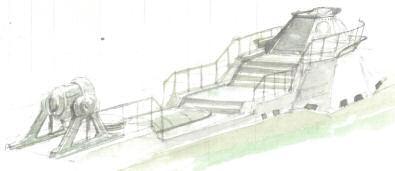
JOB TASK ANALYSIS: Speeding the Blade of the Revolution in Training
by William Kenny, Submarine Learning Center Public Affairs
For future training to better benefit Sailors, the Submarine Force, and the Navy, the submarine community needs an assessment of how individual training is conducted now – examining the “when,” “where,” and “how” of the business so that we can begin making required changes. The Revolution in Training provides a roadmap, and Job Task Analysis (JTA) is a primary tool for plotting a course for each Sailor’s life-long learning.
CWO4 James Brink, a Submarine Learning Center (SLC) JTA Assessment Team member, offered a quick definition of the concept. “Simply put,” Brink explained, “JTA is a procedure for each rating that breaks down all the Jobs and Tasks required for normal performance and then Analyzes these to determine complexity, difficulty, training requirements, safety hazards, and relative time demands.
“JTA is an important tool for future submarine training,” he said. “Navy leaders need to analyze the overall health of a rating’s professional development vector, schedule training when it is needed – or delete it if unnecessary – assess training gaps, and evaluate what Sailors are ‘trained on.’ At the same time, they should be finding ways to document proven skills and provide Sailors with civilian equivalency certificates.”
For Submarine Force training, JTA is not a priority but the priority, said Brink. “All submarine ratings for which the Submarine Learning Center is responsible have completed the initial phase of the JTA process. We need to identify every job or task a Sailor performs to fully validate the ones identified in fleet surveys and also to support the training specialists who define corresponding Skill Objects (SOs).” By definition, Skill Objects are a grouping of like tasks. These tasks are trained together, performed together, evaluated together, dependent upon one another. They also require similar knowledges, skills abilities, and tools (KSATs).
As FTCM(SS) Somales pointed out, a big JTA challenge was just getting the process started. “Our Job Task Analysis began by reviewing all documents that describe Sailor tasks, including PMS, qualifications, courses of instruction, technical manuals, input from subject matter experts, and numerous other sources. This data was then placed on a professional development continuum in accordance with fleet surveys that told us what Sailors were actually doing.”
“You start at the beginning, and you don’t stop identifying tasks until they are all accounted for,” Brink added. “This is the ‘dirty work’ of studying the professional development vector. Once the jobs and tasks are laid out, additional analysis shows how the required knowledge, skills, improved throughout, getting better as we went along.
abilities, and tools (KSATs) are supposed to be provided. If the necessary KSATs are not being supplied, the Navy needs to provide them. If appropriate KSATs have been provided, but Sailors aren’t retaining the information, the corresponding training may then need to be scheduled just before it’s needed – a just-in-time scenario.”
In the submarine community, the fire control technicians (FTs) went through JTA first, and FTCM Somales recalls an associated pitfall. “We found ourselves at times being too specific in some areas and actually in danger of losing the overall concept,” he said. This was due mostly to ‘over-exuberance,’ as I call it, since we made sure that we did the job right the first time and captured every task a Sailor might do, no matter how minute. We ship. And by then, those KSATs may be obsolete from lack of need!”
“I’m hopeful we’ll complete the initial phase of JTA during the early summer.”
CWO4 Brink echoed Somales on both the direct and indirect value of JTA. “Without intending to be dramatic,” he noted, “JTA is the foundation of the Revolution in Training. Without JTA, a submarine would never leave the pier. For the Sailor, it results in improved retention, because he can sense when his skills are at their peak, and he’ll be more likely to enjoy his job because he’s better at it. The JTA process reduces the time a Sailor spends in the schoolhouse learning KSATs he may not need until long after he’s onboard his
Master Chief Somales added that for a community with a heritage in technological innovation, driving the Revolution in Training with JTA was not only logical, but also inevitable. “Our training system has served us well but doesn’t fully capture the potential of new technology to provide training to our Sailors. With these new developments, we can provide not only training that’s relevant and timely –we’ll be able to update and provide that training much more rapidly. And we’ll also provide each Sailor the capability to see exactly where he is along his career path and to set goals and make changes based upon his progress.
Changes Of Command
USS Los Angeles (SSN-688)
CDR Thomas P. Stanley relieved CDR Christopher B. Thomas
USS La Jolla (SSN-701)
CDR Brian T. Howes relieved CDR Phil Sawyer
USS Pennsylvania (SSBN-735)(B)
CDR Michael J. Dobbs relieved CDR Timothy N. Daseler
USS Alabama (SSBN-731)(G)
CDR Melvin E. Lee relieved CDR Jonathan A. Dowell
USS Helena (SSN-725)
CDR Douglas E. Wright relieved CDR Timothy C. Bertch
Qualified For Command
LCDR James Belz USS Kentucky (SSBN-737)(G)
LCDR Brien Dickson USS Ohio (SSGN-726)
LCDR Richard Dubnansky USS Key West (SSN-722)
LCDR Jeffrey Heydon USS Henry M. Jackson (SSBN-730)(G)
LCDR Trevor Tyler USS Alabama (SSBN-732)(G)
Limited Duty Officer Qualified In Submarines
ENS Thomas Layne COMSUBRON-7
Supply Corps Officer Qualified In Submarines
LTJG Jason Hoftiezer USS Alabama (SSBN-731)(B)
LTJG Llahn Mcghie USS Houston (SSN-713)
LT Glenn Wright USS Nevada (SSBN-733)(G)
Technology of Jules Verne continued from page 28
join Nemo and his men for a series of vividlydepicted underwater expeditions, where they get to experience both the wonders and dangers of the deep.
Despite Nemo’s obsessive, vengeance-driven dark side, Verne credits him with unparalleled accomplishments as an underwater scientist and explorer. Among his many discoveries are the lost continent of Atlantis, a subterranean passage between the Red Sea and the Mediterranean (i.e., a subaqueous Suez Canal), countless new species of undersea life, and new findings in oceanography. He maps the ocean bottom, measures thermal profiles, and observes that in all the deeps of the world, the water temperature approaches the same limiting value of 4.5 degrees Centigrade. He skillfully conns Nautilus through the Strait of Gibraltar by taking advantage of the same deep-lying, outward-flowing current layer exploited by savvy submariners in two world wars decades later. In the wonderful world of Twenty Thousand Leagues, there is seemingly nothing that Captain Nemo cannot do.
The Undersea Legacy of Jules Verne
Accelerating progress in fielding undersea vehicles in the late 19th century – and rapid advances in both natural science and engineering technology – created the milieu within which Verne launched his “submarine novel.” For a non-specialist, Verne was unusually wellinformed about recent progress in the science and technology of his times. Consequently, his reputation as a futurist rests not only on his imaginative predictions of things to come, but also on his uncanny skill in crafting convincing extrapolations of the technologies of his era to achieve those visions. Flying continental distances, journeying to the moon, penetrating to the center of the earth, exploring the depths of the ocean at will – all these had been thought of by other men. But it was Jules Verne who first popularized notional solutions to these challenges and created a sense of possibility that had been absent before.
So alive does Nemo become for us in Twenty Thousand Leagues Under the Sea that generations of readers have been tempted to credit him with creating Nautilusand stimulating our subsequent fascination with the undersea world. But it is really the broad erudition –and extraordinary imagination – of Jules Verne that illuminate these pages, much as Nemo’s Ruhmkorff lights illuminated the treasures of the deep. Verne died in 1905, just as the first generation of modern submarines reached fruition and less than a decade before they achieved their first lethal successes in undersea warfare. In foreseeing the possibilities inherent in the submarine 35 years before, he had been right about some things and wrong about others, but the likelihood of fulfilling all the essentials of his vision is now little doubted.
Authors note: The best modern translation of Twenty Thousand Leagues Under the Sea is that of Walter James Miller and Frederick Paul Walter (Naval Institute Press, Annapolis, 1993). This version restores all of the French text customarily deleted in earlier English translations, and it includes many helpful annotations. Another useful source of information on the technical details of Nautilus, as well as a fascinating survey of past and present representations, is the website of Michael and Karen Crisafulli, http://home.att.net/~karen.crisafulli/nautilus.html.
Notes 1 That same year, the Franco-Prussian War broke out – much to
France’s ultimate disadvantage – and Verne served briefly as commanding officer of a small coast guard vessel at Le Crotoy near the mouth of the Somme. Reportedly, during that period he wrote the drafts of four novels! 2 By Verne’s reckoning, 20,000 leagues is about 43,000 nautical miles. 3 In a subsequent Jules Verne novel, The Mysterious Island(1875),
Captain Nemo reappears near the end of his life, he and Nautilus having survived their encounter with the Maelstrom to continue their underwater quest. It emerges that Nemo was born Prince Dakkar, an Indian rajah’s son of extraordinary intellect, who was provided a comprehensive education in Europe, where he developed unparalleled artistic and scientific capabilities. After he returned to India, Prince Dakkar became a leader of the gathering independence movement that erupted in the “Great Indian Mutiny” of 1857, which was brutally suppressed by the British. Although Dakkar’s family was massacred in the upheaval, he himself escaped, gathered an international band of what might be called today “freedom fighters,” and built Nautilus in secret as an instrument of vengeance against oppression world-wide – and particularly against the British. 4 Professor Aronnax contradicts himself in describing Nautilus’s hull plating. When first stranded on top, he notes, “That blackish back on which I was sitting was glossy and smooth, with nothing like overlapping scales.” Some days later, he says, “I noticed that its iron plates, slightly overlapping each other, resembled the scales covering the bodies of large terrestrial reptiles.” Moreover, the hull is described as iron in one passage and steel in another. 5 In size and shape, Nautilus is similar to the former experimental submarine USS Albacore(AGSS-569) launched in 1953: 203 feet long, 1,242 tons surfaced, 1,847 submerged. However, in comparing the ratio of surface to underwater displacement, Nautilus more closely approximates subsequent nuclear-powered attack submarines, such as the USS Los Angeles (SSN-688) class. 6 Interestingly, an electric boat powered by a Bunsen-cell pile was apparently demonstrated in Paris in 1871. 7 At one point, Verne refers to “Ruhmkorff cells,” but this is probably an error. 8 Covering four vertical leagues in four minutes corresponds to an average rate of rise of 130 knots – hardly likely! 9 An inconsistency appears in Captain Nemo’s description of his portable light source. There he speaks of “a Bunsen battery that I activate not with potassium dichromate but with sodium.” Previously, he described replacing the Bunsen cell’s zinc elements with sodium. Interestingly, Verne had already prognosticated such “Ruhmkorff lights” in Journey to the Center of the Earth and From the Earth to the Moon.
From Humble Origins
continued from page 15
hostilities do break out, the American submarine force will undoubtedly be in the thick of the fight.
Bibliography:
Cole, Bernard D., The Great Wall at Sea: China’s Navy Enters the 21st Century (Annapolis: Naval Institute Press, 2001)
Huang, Alexander C., “The PLA Navy at War, 1949-99,” in Mark A. Ryan, David M. Finkelstein, and Michael A. McDevitt (eds.) Chinese Warfighting: The PLA Experience Since 1949 (Armonk, NY: M.E. Sharpe, 2002)
Kondapalli, Srikanth, China’s Naval Power (New Delhi: Knowledge World, 2001)
Lewis, John and Xue Litai, China’s Strategic Seapower: The Politics of Force Modernization in the Nuclear Age, (Stanford: Stanford UP, 1992)
Mann, James, About Face: A History of America’s Curious Relationship with China, From Nixon to Clinton (New York: Random House, 1998)
CAPT Shen Zhongchang, LCDR Zhang Haiyin, and LT Zhou Xinsheng (PLAN), “21st Century Naval Warfare,”in Michael Pillsbury (ed.), Chinese Views of Future Warfare (Washington, DC: National Defense University, 1997)
Swanson, Bruce, Eighth Voyage of the Dragon: A History China’s Quest for Seapower (Annapolis: Naval Institute Press, 1982)
Dr. Lyle Goldstein is an associate professor in the Strategic Research Department of the U.S. Naval War College, where he specializes in Chinese and Russian security policies. Bill Murray is an associate professor in the War Gaming Department at the Naval War College. He is a retired submarine officer and served on Los Angeles-class submarines.
Floating Drydock Resolute Ends 58-year Career by JOC(SW/AW) Mark O. Piggott, COMNAVSUBFOR Public Affairs
After 58 years of service to the U. S. Navy, the Medium Auxiliary Floating Drydock Resolute (AFDM-10) was inactivated at a ceremony at Naval Station Norfolk on November 7, 2003. Resolute was one of a kind, the last of her class serving submarines on the East Coast.
“Resolute is an engineering marvel,” said CAPT Bruce E. Grooms, Commodore, Submarine Squadron 6. “Her 139 safe and accident-free drydockings are the direct result of hard-working, dedicated crews. I salute you and your superb efforts,” he continued, “to make Resolute one of the finest drydocks the Navy has ever known.”
Resolute was built by the Chicago Bridge and Iron Works in Newburg, New York in 1944 and entered active service as YFD-67 the next year. Designed to forward-deploy with the fleet and keep ships battle ready, Resolute joined the war effort just before the end of the Pacific conflict.
“Resolute, born of the fighting spirit that made and keeps our nation strong, has had a varied and at times indeterminate history,” said CDR Douglas J. Holderman, her Commanding Officer. “Yet it is not her steel skin alone that bestows that spirit, but rather her crew…” he added, “…and the devotion to duty and loyalty to country that goes into keeping this rather large chunk of steel active for 58 years, ready to serve.”
Since arriving in Norfolk, Resolute has safely docked 139 submarines, and completed 55 Selected Restricted Availabilities (SRA) without incident. Resolute has been awarded seven Battle “E” Efficiency ribbons, two Meritorious Unit Commendations, two National Defense Service medals and was awarded the Chief of Naval Operations Safety Award in 2001 for outstanding contributions to fleet readiness.
Line Officer Qualified In Submarines:
LTJG John Bacholzky USS Olympia (SSN-717)
LTJG Robert Bogan USS Michigan (SSBN-727)(B)
LTJG Nicholas Borman USS Olympia (SSN-717)
LTJG Benjamin Britt USS Pennsylvania (SSBN-735)(B)
LTJG Scott Brockman USS Pennsylvania (SSBN-735)(B)
LTJG Samuel C. Gray USS Tennessee (SSBN-734)(B)
LTJG Philip Castellano USS Asheville (SSN-758)
LTJG Michael Garner USS Michigan (SSBN-727)
LTJG Robert Gautier USS Parche (SSN-683)
LTJG David George USS Portsmouth (SSN-707)
LTJG Marcus Gioe USS Chicago (SSN-721) LTJG Heath Heist USS San Francisco (SSN-711)
LTJG George Howell USS Henry M. Jackson (SSBN-730)(B)
LTJG Nicholas J. Hill USS Nebraska (SSBN-739)
LT Quintin James USS City Of Corpus Christi (SSN-705)
LTJG Gregory Johnson USS Pennsylvania (SSBN-735)(B)
LTJG Pratik Joshi USS La Jolla (SSN-701)
LTJG Horacio Larios USS Greeneville (SSN-772)
LTJG Bruce M. Reilly USS Montpelier (SSN-765)
LT Jeffrey Mills USS Columbus (SSN-762)
LTJG Hoang N. Tran USS Montpelier (SSN-765)
LTJG August Negele USS Michigan (SSBN-727) LTJG Trent Neville USS Henry M. Jackson (SSBN-730)(B)
LTJG Thomas Niebel USS La Jolla (SSN-701)
LTJG Randal P. Shaffer USS Maine (SSBN-741)(B)
LT Jeremy Pelstring USS Michigan (SSBN-727)
LTJG Jason Pepin USS Nevada (SSBN-733)(G)
LTJG Weylin Piegorsch USS Olympia (SSN-717)
LTJG Craig Prost USS Pasadena (SSN-752)
LTJG Thomas Resig USS Alaska (SSBN-732)(B)
LTJG Matthew Rivera USS Nevada (SSBN-733)(G)
LTJG Kenneth Rogers USS Alaska (SSBN-732)(G)
LT Joseph Root USS Columbia (SSN-771) LTJG Jonathan Ross USS Alabama (SSBN-731)(B)
LTJG Chad Roum USS Alabama (SSBN-731)(B)
LTJG Aaron Running USS Nevada (SSBN-733)(B)
LTJG Logan Schulze USS Los Angeles (SSN-688)
LTJG Raj Singaraju USS Buffalo (SSN-715)
LTJG Michael Stodick USS Portsmouth (SSN-707)
LTJG Corbyn Thorsen USS Alaska (SSBN-732)(B)
LTJG Jon Vorachek USS Henry M. Jackson (SSBN-730)(B)
LTJG Robert Yovich USS Olympia (SSN-717)
SUBRON 3 Senior Chief on Target by JO3 Corwin Colbert, USN
With extreme patience, he slowly pulls the trigger and, with a bang, another nearperfect shot pierces the target silhouette.
Electronics Technician Senior Chief Greg Silvey, Submarine Squadron 3, shoots with determination and precision, which is why he sports a unique badge on the left shoulder of his khaki uniform. It is the President’s Hundred badge, given to those ranked among the top 100 competitors in service pistol shooting. Silvey ranked 51st in the President’s Hundred, 3rd in the Expert Service pistol match, 9th in the National Trophy individual match, and 1st on the U.S. Navy Pistol shooting team. He has been in the U.S. Navy for 21 years and has been firing small arms for even longer.
According to Silvey, his fascination with shooting started when he was quite young. “The first gun I fired was when I was 10 years old with my father on my grandparent’s ranch in Santa Paula, California. It was an M-14 rifle. We were shooting cans and bottles near a riverbed we used for practice,” said Silvey.
Silvey has a variety of firearms and remembers when he purchased his first weapon. “The first gun I ever bought was a .357 Magnum. I felt comfortable with it, and that’s why I bought it. It got it for self-defense, because one day, when I was helping a friend build a log cabin back in Georgia in my spare time, we got shot at by poachers. The local sheriff told us it would be in our best interest to own a firearm for protection. I started being interested in competing when I took that .357 Magnum out to the range.”
In his free time, Silvey shoots at Koko Head public shooting range, where he also competes as part of the local Chinese Gun Club. Lester Higa, a Honolulu native, is a Chinese Gun Club teammate.
“Greg and I are a part of the Chinese Gun Club. I met him through another one of our bullseye shooters. To be a bullseye shooter takes a lot of practice and patience,” said Higa. “Greg is very dedicated to the sport. He comes out to practice, not to socialize. I think he sets a really good example of what a bullseye shooter should be doing at a practice session,” said Higa. “During a match, Greg has a tremendous amount of concentration. When he has 10 minutes he takes the full 10 minutes. Sometimes it is a little frustrating because we are all finished shooting and we are waiting on Greg,” Higa chuckles. “It will be nine minutes and 45 seconds and he will shoot the last shot. His ability is improving every day, provided he gets the practice time in, and he is able to make the matches. Unfortunately, he lost some momentum due to his service duties, but he has been gaining it back,” concluded Higa.
“I have been to three nationals, and I will be there for 2004,” said Silvey. “The national championship is held at Fort Perry in Clinton, Ohio. It’s interesting to meet people at the competitions and find out what they do and how they got into competing. You make friends there, and they’re friends for life. It’s a big social event.”
Silvey hopes some day to break former Navy service member Donald L. Hamilton’s record. “Not only just to break the record, but to keep it Navy as well,” remarked Silvey. “Hamilton’s score was 2,688 out of 2,700. The best I’ve done is 2,636 out of 2,700, but I’ve been breaking 2,600 for a while, and I think I have a chance.”
Qualified Nuclear Engineer Officer
LT Stephen Fisher USS Nevada (SSBN-733)(B)
LTJG Ismial Aljihad USS Alabama (SSBN-731)(B)
LTJG Joseph Bobrowski USS Michigan (SSBN-727)(B)
LTJG Robert Bogan USS Michigan (SSBN-727)(B)
LT Tullio Celano III USS Jefferson City (SSN-759)
LT David Edgerton USS Honolulu (SSN-718)
LTJG Steven Everhart USS Ohio (SSBN-726)(B)
LTJG Maurice Greer USS Los Angeles (SSN-688)
LTJG Daniel Hogan USS Pennsylvania (SSBN-735)(G)
LTJG Matthew Holland USS Salt Lake City (SSN-716)
LTJG James Hough USS San Francisco (SSN-711)
LTJG Stephen Korupp USS City Of Corpus Christi (SSN-705)
LTJG Bradley Lambert USS Pennsylvania (SSBN-735)(G)
LTJG Ramon Martinez USS Kentucky (SSBN-737)(B)
LTJG Nathan Mills USS La Jolla (SSN-701)
LT Andrew Omeara USS Jefferson City (SSN-759)
LTJG Kyle Partridge USS Alaska (SSBN-732)(G)
LT Jon Phillips USS Greeneville (SSN-772)
LTJG Andrew Platten USS Columbia (SSN-771)
LTJG William Swanbeck USS Asheville (SSN-758)
LTJG Jon Uyboco USS Louisville (SSN-724)
LTJG Chimi Zacot USS Tucson (SSN-770)
Honolulu Surfaces at the North Pole
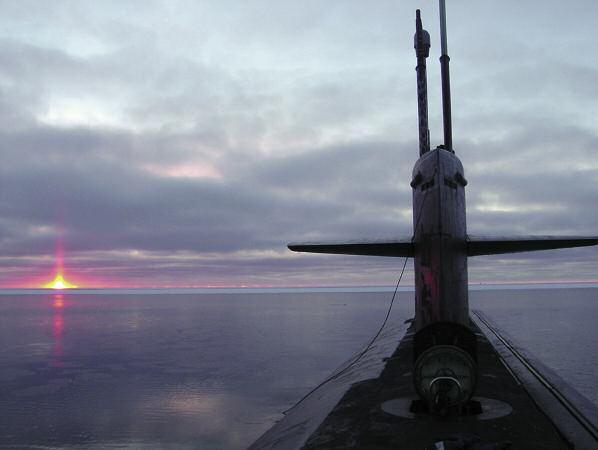
The Los Angeles-class fast-attack submarine USS Honolulu (SSN-718) surfaced in an open water area approximately 280 miles from the North Pole in October 2003. While conducting otherwise classified operations in the Arctic, Honolulu collected scientific data and water samples for U.S. and Canadian universities as part of an agreement with the Artic Submarine Laboratory (ASL) and the National Science Foundation (NSF). Commanded by CDR Charles Harris, Honolulu is the 24th Los Angeles-class submarine, to visit the North Pole region. Honolulu is assigned to COMSUBPAC, Submarine Squadron 3, Pearl Harbor, Hawaii. Pictured right, three polar bears approach Honolulu’s starboard bow. Sighted by a lookout from the sail of the submarine, the bears investigated the boat for almost two hours before leaving.

On The Back
“The Submarine ‘Nautilus’ in dry-dock 371 nautical miles NNE of Vanikoro” by Dave Warren. According to Verne’s Captain Nemo, Nautilus was built in secret on a deserted island in the Pacific Ocean using components ordered under various pretexts from all over the industrialized world. This is English artist Dave Warren’s conception of the submarine nearing completion but still on the stocks. Mr. Warren has been a film industry art director for 10 years, but he created his Nautilus drawings largely as an avocation. He lives near London. See the “Submarine Technology of Jules Verne” on page 24.
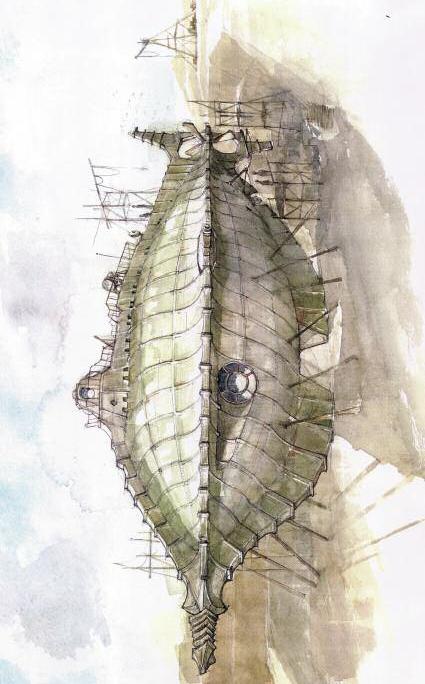
by Dave Warren






